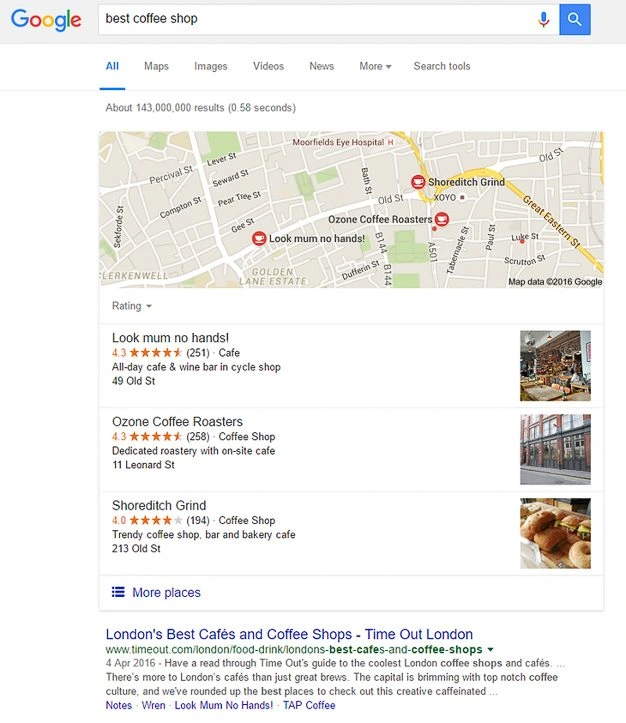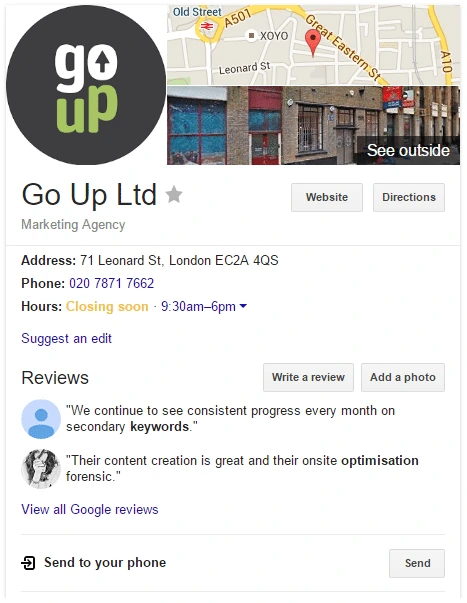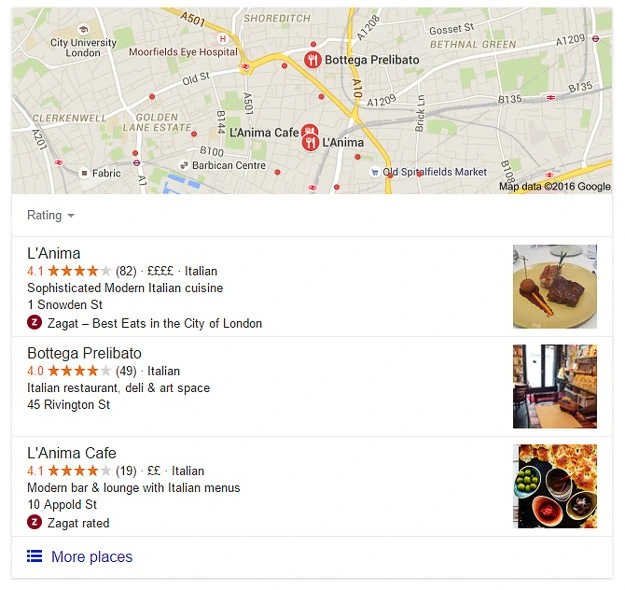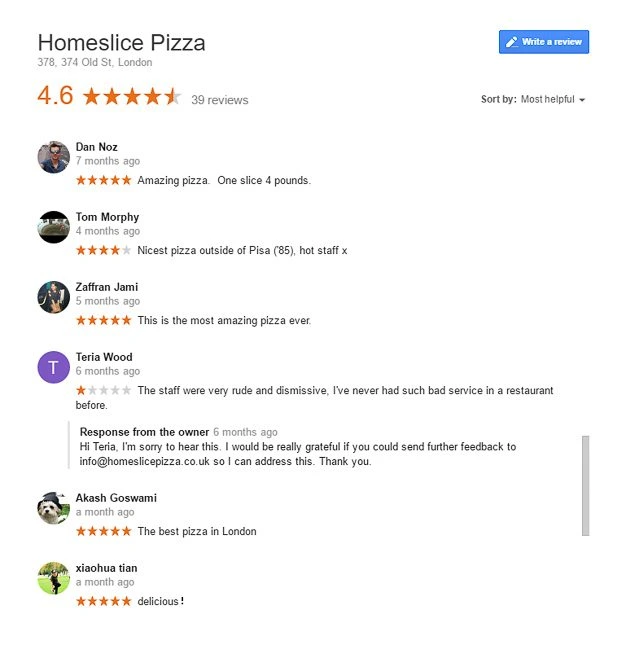
5 mins
OpenHow Important Are Citations In Local SEO?
5 mins
People are using search to find local information more than ever before, so it’s vital for businesses with a physical address to rank highly for search queries with local intent. This is where local SEO comes in.
1st July 2016

95% of mobile users look up local information on their phones, mostly with the intent to call or visit a business.
Google recently revealed that 95% of mobile users look up local information on their phones, mostly with the intent to call or visit a business. Because of this, it’s more important than ever before for local businesses to be ranking highly for local search terms.
Mobile connectivity has empowered the modern day consumer. With information available at the touch of a button, consumers have come to expect instant gratification – 89% of consumers expect to be able to get what they want, whenever they want. Consequently, the average internet user is far more likely to click on search engine results that are above the fold, rather than endlessly scrolling to find what they are looking for.
Because of the modern consumer’s need for instant information, it’s absolutely vital for local businesses to be ranking highly for search terms related to their area. This is where local SEO comes in.
Much like traditional SEO, local SEO involves the optimisation of onsite and offsite signals to improve a website’s online visibility. However, local SEO is focused on providing results that are relevant to a searcher based on their current location.
Since Google’s 2014 Pigeon update, which was designed to provide more useful, relevant and accurate local search results, it has become vital for any business with a physical location to harness the power of local optimisation.
To demonstrate how local SEO works, try searching for “best coffee shop” on Google. You’ll notice that the results provided are all nearby. This is because Google knows where you are located by your IP address – it will serve up local coffee shops even though you didn’t enter a geographical term.

Locational search phrases are often searched at the purchase stage of the buying cycle, meaning local SEO carries provides a higher conversion rate on average.
Businesses can attract new customers from the local area, or even those just passing through, by showing up for local search queries. Furthermore, locational search phrases are often searched at the purchase stage of the buying cycle, meaning local SEO carries provides a higher conversion rate on average.
Just like traditional optimisation, a number of onsite and offsite components contribute to local search performance. No two campaigns are ever identical. Each website needs a tailored strategy that carefully blends and balances several factors to achieve the best results.
Here are several of the components needed for a successful local SEO campaign:
The first step of any local SEO campaign should be to claim your free business address on Google My Business (GMB). GMB, also known as Google Places, allows businesses to share their information on Search, Maps and Google+, making them visible on search to customers in the local area, no matter what device they’re using. Think of it as the internet’s version of the Yellow Pages, only far more simple and efficient.
GMB listings appear on the right hand side of search results on desktop. On mobile, GMB listings appear at the very top of search results.
The advantage of GMB is that all relevant information about your business is available in an instant. For instance, adding a phone number allows a customer to call at the tap of a button. Alternatively, adding an address allows customers to instantly obtain directions through Maps. GMB also allows customers to leave feedback in the form of reviews, but more on that later.
Having a complete GMB profile is proven to increase conversions. Consumers are 38% more likely to visit and 29% more likely to consider purchasing from businesses with complete listings. It’s therefore absolutely vital that profiles are completed with accurate information, particularly contact details, location and hours of operation.

Consumers are 38% more likely to visit and 29% more likely to consider purchasing from businesses with complete Googe My Business listings.
Having a GMB profile also increases your chances of appearing in Google’s local pack. Ever since Google rolled out its Pigeon update, search results for queries with local intent have displayed a ‘3 Pack’ podium of organic business results. These results feature a map, directions, contact information and a link to the business’s website.
Importantly, Google’s local pack only features local businesses that have successfully optimised their GMB page and website for local communities. Providing accurate category information about your business gives Google a better understanding of your website, making it more likely to appear in its 3 pack of localised search results.
Google’s local pack is positioned above organic search results. This means it is above the fold on desktop search results, and even though it is below the fold on mobile, being positioned higher than organic results increases visibility. Ultimately, it could lead to more traffic and conversions than competitors not featured in the pack.
 Google’s local pack as it appears in desktop search results.
Google’s local pack as it appears in desktop search results.
Online reviews can be a double-edged sword for businesses – positive feedback is marketing gold, while criticism can damage reputation. However, reviews have a direct impact on local search rankings, so you should encourage clients and customers to leave them. Businesses with more reviews and higher average ratings are more likely to appear on Google’s Local Pack.
Furthermore, reviews and ratings hold a powerful effect on the behaviour of your audience. 90% of consumers read online reviews and more than half of those will visit a website after reading positive feedback. This means that if you’re not displaying product or company reviews, you’re alienating a large portion of the consumer population, depriving them of information that helps to make purchase decisions.
Unfortunately, unhappy customers are the most likely to post reviews. Because of this, it’s important to reach out and ensure that your customers are happy. If they are, simply ask them to leave feedback on Google, reminding them how easy it is to do so on mobile or desktop. You’ll be surprised by how many are willing to do this. Alternatively, you could create a reviews page on your website or provide an incentive to leave feedback such as entry to a competition or discount vouchers.
If you do receive a negative review, don’t fret – use it as a PR opportunity. By replying to negative reviews you can provide advice or offer apologies, showing you genuinely care about your customers. Besides, too many good reviews may look suspicious. Occasional criticism makes the glowing five star reviews seem more sincere.
If you’re not displaying product or company reviews, you’re alienating a large portion of the consumer population, depriving them of information that helps to make purchase decisions.
 Responding to negative reviews shows you genuinely care about your customers.
Responding to negative reviews shows you genuinely care about your customers.
According to MOZ’s annual local search ranking factor survey, onsite content is one of the most influential aspects of a website’s performance in local search. It’s therefore important to squeeze the most value out of your content.
Firstly, Schema markup should be used to mark up the business’s name, address and phone number. This helps search engines to return more informative results for users. The name of the city or town where the business is located should also be included in the website’s URL, title tags, H1 and H2 headings, meta description and within content.
It’s also important to remember that many customers will access your site directly rather than through search, bypassing your GMB profile with location and contact information. To ensure customers have access to this information, embed the map from your GMB listing on your main landing page.
Search engine spiders favour unique content that is regularly updated. Frequently adding or updating blog posts is a good way of ensuring a website increases its amount of unique content.
When optimising for local SEO, blog posts need to be relevant to the local area or to be of genuine interest to your customer. For instance, commenting on local news and discussing how it may affect your industry, posting guides on upcoming local events or simply answering frequently asked questions are all topics relevant or useful to those living nearby
Google’s Pigeon update has already placed more importance on local SEO and, unless you already have a nationally established presence online, it is going to become more and more of a necessity in the coming years. Take measures to implement an ongoing local strategy now and you may get a head start on your closest competitors. As changes to the SEO landscape continue to favour locally optimised businesses, you’ll only stand to benefit more.